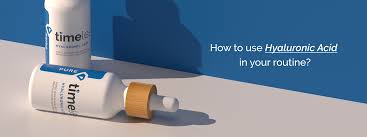Can You use Pure 100 Percent Hyaluronic Acid?
Hyaluronic acid is a favourite of many, and with good reason. It’s ultra-hydrating traits and ability to be used on all skin types with various skincare ingredients demonstrates how impressive it is, and how every skincare routine would benefit from this hydrating addition. There is a dedicated blog post about the skin benefits and how it works on the skin over on The Beauty Insiders, so do check that out to find out more.
The focus of today’s blog post however, is understanding whether you can use pure 100% hyaluronic acid? Is it that much better than the other concentrates available? This is exactly what we will be finding out, so let’s dive right in and find out more.
Can you use 100% hyaluronic acid?
Yes, you certainly can! You’ll find that 100% hyaluronic acid formulas have a watery consistency that is light weight and easily absorbed into the skin. Suitable for all skin types you can introduce this clean ingredient into your daily routine with the peace of mind that you will avoid any flare-up of skin irritation or reaction.
You’ll find that the humectant properties of hyaluronic acid ensure it is able to draw moisture into the skin from the area surrounding the face and locking it into the surface. This will not only help other products penetrate rapidly into the lower layers but will also ensure the protective skin barrier contains the correct levels of water leaving it strengthened. This allows the skin barrier to ward off any skin damage caused from exposure to free radicals, such as pollution, UV rays, and other environmental aggressors.
What is the best percentage of hyaluronic acid to use?
Now, I may have just described how effective 100% pure hyaluronic acid can be for the skin, but believe it or not, you can have too much of a good thing. By this I mean that the humectant traits of hyaluronic acid are so potent that if you apply too much of the acid to the face, it will in fact begin to draw water up from the lower layers of the skin. This will then lead to the skin begin to feel dry, tight, and uncomfortable rendering hyaluronic acid completely ineffective to perform its benefits on the skin.
Can I use only hyaluronic acid?
You can use it on its own, but there are some other ways you’ll find it will work more effectively and deliver quicker results. Many find that during the winter months their skin becomes excessively dry, tight, and uncomfortable. By applying hyaluronic acid daily, you are able to lock moisture in keeping the complexion plumped, hydrated, and in its healthiest state. As effective as hyaluronic acid is at keeping the skin barrier moisturised there are some ways of using it in your daily routine that will give the humectant a super charged boost. Here are three top tips of how to apply hyaluronic acid to the skin and the benefits you can expect to see when using it in your daily regime.
Always ensure you apply hyaluronic acid to skin that is still slightly damp. This gives the humectant a springboard approach to locking as much water into the skin surface as possible. Once it has absorbed all the water from the face it will move onto the water in the atmosphere surrounding. This will ensure you avoid the hyaluronic acid drawing water up from the lower layers and begin a vicious cycle of dryness and irritation.
With the plethora of skin benefits hyaluronic acid can deliver to the skin, there is one that is often forgotten about and that is how the humectant keeps the skin at its most absorbent state. Imagine it as though your skin is a wet sponge, and anything applied soaks in rapidly. Serums enriched with active ingredients can be layered with hyaluronic acid meaning the potent formula can penetrate deeper into the most effective areas of the skin.
Finally, you can help your hyaluronic acid deliver even more results by applying a face oil or moisturise that is packed with nourishing ingredients such as vitamin E or squalene. This will not only form a physical barrier on the outer surface but will also provide extra water for the HA to draw into the skin.
There is some information about using hyaluronic acid in your daily skincare routine, but if you needed a little more help about how to layer hyaluronic acid serum there is a full dedicated blog post so do check it out when you can.
How do I use pure hyaluronic acid?
You can use pure hyaluronic acid the same way you apply any skincare product containing the clever humectant. The general skincare rule when it comes to application of your products is starting with the thinnest consistency and building up the thickest. Here is an example of the steps needed for a simple, everyday skincare routine.
Makeup removing micellar water/cleanser
Face wash
Exfoliating toner
Serum
Face oil
Moisturiser
SPF (AM only)
You’ll often find hyaluronic acid makes its way into different types of product formulas. This is because of how easily HA can work with other ingredients and blend seamlessly into potent skincare products. Having said that, the percentage of the acid is often higher in products such as serums, face oils and moisturisers so if it’s fast results you are after then it’s best to opt for using these daily. As for pure hyaluronic acid, this usually comes in serum form but as I have mentioned previously too much HA can have the reverse effects so always ensure you consult with a doctor or dermatologist to find the best formula to work for you and your skin.
So, there you have it, a little more knowledge about 100% pure hyaluronic acid and how it works on the skin. Don’t forget if you have any questions you can follow us on Instagram, you’ll find me in the direct messages!
DQH Knowledge drop: In your 20s, your skin cell turnover decreases. (Cell turnover is a key component in keeping your skin youthful.) You know what else slows down? Your collagen production. Starting in your 20s, collagen decreases by about 1 percent per year. Should you want to prevent fine lines and wrinkles, start by eliminating behaviors that contribute to premature aging. “If it’s bad for you, it’s bad for your skin,” says dermatologist Michel Somenek.
“Cigarette smoking reduces blood flow to the skin and causes premature wrinkling and a dull skin texture. Making the repeated pursed motion to inhale can also cause smoker’s lines. Alcohol and recreational drugs are toxins for the skin that damage its cellular structure and DNA,” Somenek tells us. “The faster you eliminate vices while you are young, the better chance your skin and body have to recuperate.” Also, adopting an anti-aging routine in your 20s is key. After all, the best offense is a good defense. We spoke to Somenek and experts Joshua Ross and Audrey Kunin to find out more.
Keep reading for the best anti-aging products for your 20s, according to skincare professionals.
Sunscreen
“We all know that the sun is the number one cause of skin aging and starting the prevention in your 20s is very important,” Ross says. “The majority of your sun damage won’t start to appear until you’re in your 30s, so don’t wait until you see it surface or you’ll be behind the curve. Stay ahead of it with a good-quality zinc-based sunscreen worn daily.”
Farmacy Green Defense Daily Mineral Sunscreen
An invisible sunscreen with SPF 30, plus botanical extracts meant to protect skin with tons of antioxidants. Bonus: It’s clean and fine to use under makeup.
Bareminerals Complexion Rescue™ Tinted Moisturizer Broad Spectrum SPF 30
Although we recommend you use your SPF and moisturizer separately, we also understand moments when you don’t have time or energy for that extra step. For those times, this bareMinerals moisturizer is a great thing to have on hand.
Vitamin C Serum
“A great introduction to anti-aging is to start with a vitamin C serum in your morning skincare routine,” Ross says. “It’s a powerful antioxidant that will neutralize free radicals and brighten the skin.” He adds that it’s a great way to counteract the effects of the sun’s harmful rays, which, as previously mentioned, are among the biggest causes of premature aging.
Drunk Elephant C-Firma™ Vitamin C Day Serum
The Drunk Elephant C-Firma is a lightweight serum that promises to give skin a glow by combining the brightening powers of vitamin C with ferulic acid, l-ascorbic acid, and vitamin E. The included sodium hyaluronate is meant to replace hydration loss, so you shouldn’t have to deal with any irritation.
Sunday Riley C.E.O. Rapid Flash Brightening Serum
This potent serum is jam-packed with vitamin C (15 percent, to be exact), which means it’s a potential superstar at both brightening skin and dousing it in antioxidants.
Peptides
Using peptides on your skin has many benefits, says Somenek. “The skin barrier is what defends the body against pollution, UV rays, bacteria, and toxins. It can be damaged by several everyday factors. Using topical peptides aids in building a stronger barrier,” he says. “Peptides comprise elastic fibers, which are a type of protein. These fibers help to make skin appear taut and firm. Peptides can also help repair damaged skin, relieve inflammation, and even out skin tone. Some peptides can kill acne-causing bacteria that is common in 20-somethings.”
Kunin agrees, saying, “Peptides are an excellent entry point for supporting collagen.” She recommends looking for face and eye treatments that contain these collagen-boosting powerhouses.
Charlotte Tilbury Magic Eye Rescue Cream
This Charlotte Tilbury super-emollient eye cream has a base of coconut oil and shea butter (read: it’s incredibly hydrating). Botanicals plus peptides are meant to help reduce dark circles and boost collagen, respectively.
This creamy moisturizer serves up potent collagen-boosting peptides and pycnogenol, and antioxidant-rich vitamin C. “Instead of sitting on top of the skin, peptides penetrate the outer layer so they go deep. The ‘signals’ they send tell the cells to produce elastin and collagen, which are needed for youthful-looking skin,” explains Somenek.
At-Home Peel Pads
Remember that skin cell turnover fiasco we talked about earlier? One way to help support it is by exfoliating. “Exfoliation is important to help keep skin fresh and luminous,” Kunin says. She recommends using at-home peel pads as an easy and effective way to exfoliate.
“The goal in your 20s is to fight the slowing pace of cell turnover. It is wise to use products that gently exfoliate, yet still remove oil and other impurities. Products that have Alpha Hydroxy Acids (AHA) or Beta Hydroxy Acids (BHA) are a good choice.”
According to Somenek, you should only exfoliate two to three times a week. “People of all ages are guilty of over-exfoliating and that can be too much of a good thing,” he says.
Dermadoctor Kakadu C Intensive Vitamin C Peel Pad
A few swipes of this Derma Doctor powerful peel pad promise to leave your skin glowing and smooth, thanks to the seven (yes, seven) types of chemical exfoliants, including AHA and BHA. It also contains vitamin C via Kakadu plum extract for added brightening and antioxidant protection.
KEY INGREDIENTS Kakadu plum extract is sourced from the Kakadu plum, a fruit grown in northern Australia. It contains vitamin C, which restores the skin’s natural barrier, increases collagen production, and soothes irritation.
Dr. Dennis Gross Skincare Alpha Beta® Universal Daily Peel Pads
These are the gold standard of peel pads, with a cult following and over 900 five-star reviews on Sephora. They’re easy to use and contain a blend of anti-aging exfoliating acids.
Emollient Night Cream
“In your 20s, you need to start upping the hydration in your skincare routine. You may have been cautious of over-moisturizing because of acne in your teens, but as you enter your 20s, your skin transitions and becomes drier,” Ross says. “I recommend an emollient night cream added into your evening skincare regimen.”
“Twenty-somethings need to make sure that they are not using creams that will clog their pores and cause excess oil production,” says Somenek. Opt for non-comedogenic products.
Cerave Skin Renewing Night Cream
One great choice is the CeraVe Skin Renewing Night Cream, which is a non-comedogenic night cream that leaves skin soft and glowy. It combines the moisturizing powers of ceramides and hyaluronic acid.
RoC Retinol Correxion Max Hydration Creme
“The best night cream ingredients contain retinol, benzoyl peroxide, and/or salicylic acid or hyaluronic acid. The goal is to moisturize, yet remove excess oil,” says Somenek. This Roc Retinol Correxion cream fits the bill as it contains both hyaluronic acid and retinol so it promises to moisturize while also being non-comedogenic.



